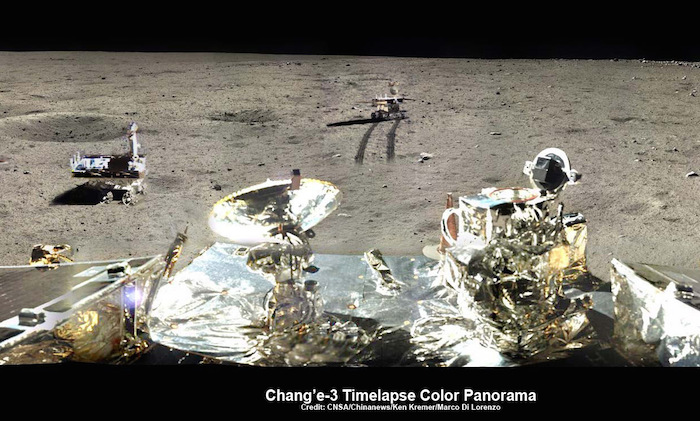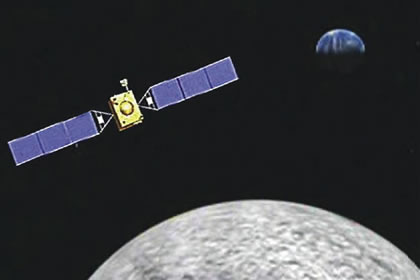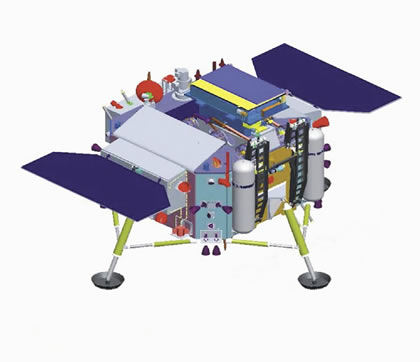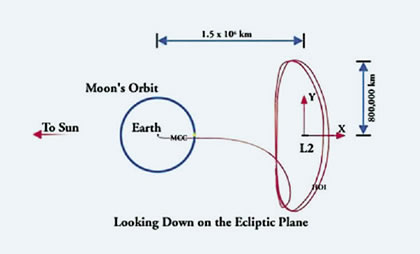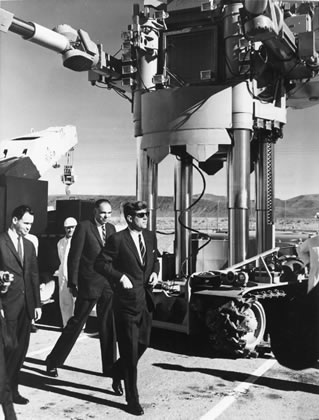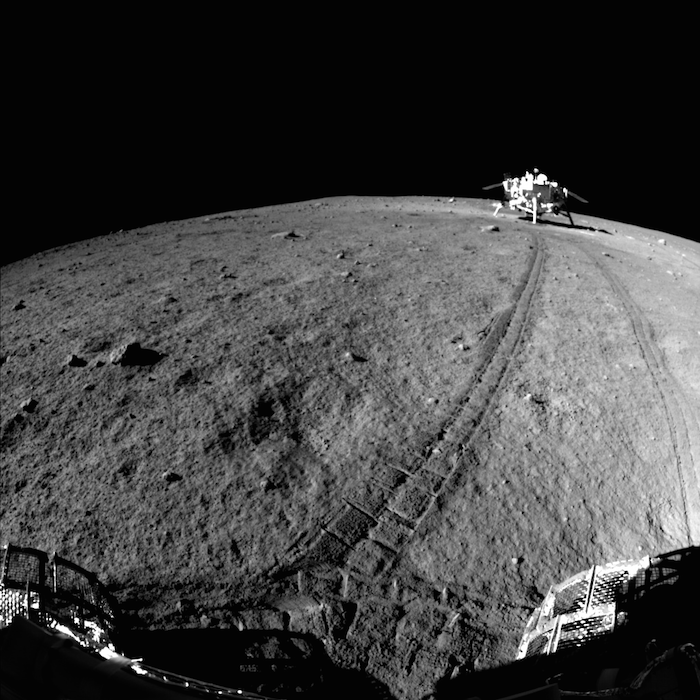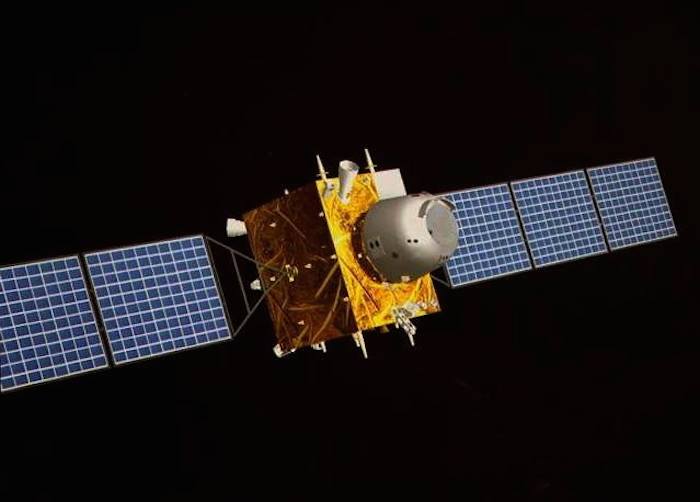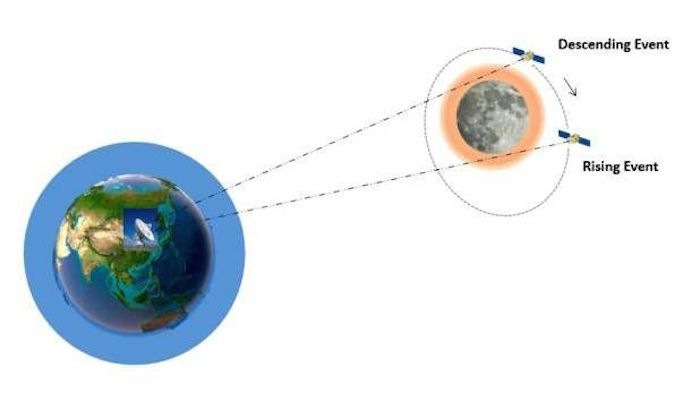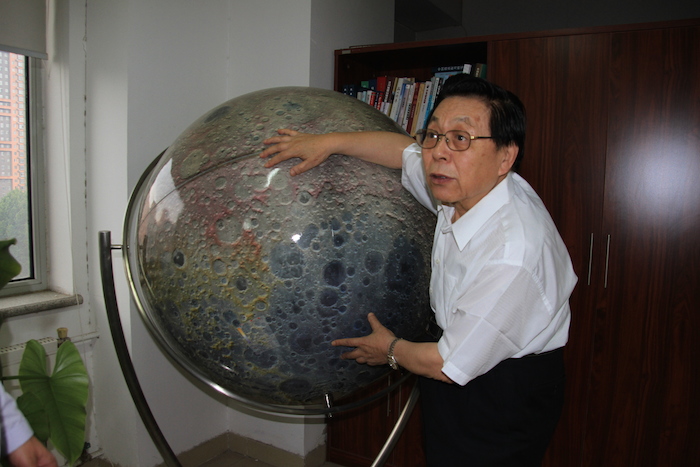The Moon man: Ziyuan Ouyang in his office at the National Astronomical Observatories with a lunar globe covered with images taken by Chinese craft. (Courtesy: Mingfang Lu)
I caught up this morning on the second day of my visit to Beijing with Ziyuan Ouyang, chief scientist of China’s Moon programme at the National Astronomical Observatories, which lies not far from the city’s iconic “bird’s-nest” Olympic stadium.
I’d first met Ouyang on my last visit in 2011 when the country had so far launched two lunar missions – Chang’e 1 (which orbited the Moon for 18 months before crash-landing onto the lunar surface) and Chang’e 2 (another lunar orbiter that later moved off into interplanetary space).
China’s lunar efforts have continued and Ouyang explained to me what has happened since my last visit – and what the country plans to do next.
In 2013 China’s Chang’e 3 mission soft-landed on the Moon, its rover transmitting data about the lunar surface before signals stopped in April 2105. Like all Chinese lunar missions, it’s named after the country’s goddess of the Moon.
Next up, Ouyang explained, is Chang’e 5, which will be China’s first lunar sample-return mission. Due to take off next year, Chang’e 5 will drill a hole two metres deep in the lunar surface, scoop out at least a kilogram of Moon rocks and load them onto a capsule that will be fired back to Earth. The Russians and Americans have returned Moon rocks to Earth before, but this will be the first time Chinese scientists have pulled off that feat.
Carrying such a heavy payload back home will require clever ways of cooling and decelerating the craft as it re-enters the Earth’s atmosphere, but fortunately Chinese researchers last year launched a simulator to practise the maneouvre.
In 2018, meanwhile, China is planning to launch the world’s first ever mission to land on the far side of the Moon. In addition to a lander and rover, Chang’e 4 will consist of a satellite at the Earth–Moon system’s second Lagrangian point, meaning that it’s always facing the far side of the Moon and so can beam data back to Earth even though that part of the lunar surface is hidden from view.
Looking even further ahead, China wants to send a mission to Mars by 2020, using a lander and rover to study the Martian climate and create a map of the surface that’s more accurate than any other country has managed. Ouyang even claims the mission will seek ways of changing Mars’s climate to render it more suitable for potential human astronauts on the red planet.
Whether that’s possible I’m not sure, but you have to admire Ouyang – still going strong at the age of 81 – for thinking big.
China Exclusive: China to send Chang'e-4 to south pole of moon's far-side
BEIJING, China aims to send the Chang'e-4 lunar probe to land in the south pole region of the far side of the moon in 2018, according to China National Space Administration (CNSA).
Scientists plan to send a relay satellite for Chang'e-4 to the halo orbit of the Earth-Moon Lagrange Point L2 in late May or early June 2018, and then launch the Chang'e-4 lunar lander and rover to the Aitken Basin of the south pole region about half a year later, said Liu Tongjie, deputy director of the CNSA's Lunar Exploration and Space Program Center.
"We plan to land Chang'e-4 at the Aitken Basin because the region is believed to be a place with great scientific research potential," Liu told Xinhua in an exclusive interview.
With its special environment and complex geological history, the far side of the moon is a hot spot for scientific and space exploration. However, landing and roving there requires the relay satellite to transmit signals.
The transmission channel is limited, and the landscape is rugged, so the Chang'e-4 mission will be more complicated than Chang'e-3, China's first soft landing mission on the moon, which was completed in 2013, said Liu.
The lander of Chang'e-4 will be equipped with descent and terrain cameras, and the rover will be equipped with a panoramic camera, he said. Like China's first lunar rover Yutu, or Jade Rabbit, carried by Chang'e-3, the rover of Chang'e-4 will carry subsurface penetrating radar to detect the near surface structure of the moon, and an infrared spectrometer to analyze the chemical composition of lunar samples.
But unlike Chang'e-3, the new lander will be equipped with an important scientific payload especially designed for the far side of the moon: a low-frequency radio spectrometer.
"Since the far side of the moon is shielded from electromagnetic interference from the Earth, it's an ideal place to research the space environment and solar bursts, and the probe can 'listen' to the deeper reaches of the cosmos," Liu said.
The Chang'e-4 probe will also carry three scientific payloads respectively developed by the Netherlands, Sweden and Germany, according to Liu.
"It's in-depth, friendly and win-win international cooperation under the leadership of the CNSA," said Liu. "The cooperation will help engineers and scientists from different countries study together. Scientists could conduct joint research and share scientific data."
The low-frequency radio spectrometer, developed in the Netherlands, will be installed on the Chang'e-4 relay satellite. The Dutch and Chinese low-frequency radio instruments will conduct unique scientific studies such as measuring auroral radio emissions from the large planets in the solar system, determining the radio background spectrum at the Earth-Moon L2 points, creating a new low-frequency map of the radio sky, and detecting bright pulsars and other radio transient phenomena.
"The Chinese and Dutch low-frequency radio spectrometers on the lander and relay satellite of Chang'e-4 might help us detect the 21-cm hydrogen line radiation and study how the earliest stars were ignited and how our cosmos emerged from darkness after the Big Bang," said Chen Xuelei, an astronomer with the National Astronomical Observatories of the Chinese Academy of Sciences.
The rover will also carry an advanced small analyzer for neutrals, developed in Sweden, to study the interaction between solar winds and the moon surface.
And a neutron dosimeter, developed in Germany, will be installed on the lander to measure radiation at the landing site. Scientists say it is essential to investigate the radiation environment on the lunar surface, in preparation for human missions to the moon.
The Chinese public, especially young people, are encouraged to participate in the Chang'e-4 mission. The CNSA launched a contest among students across China at the beginning of this year, collecting creative ideas on the design of the payloads on the lander, rover and relay satellite.
"We received a total of 257 submissions, and 20 items entered the primary selection. The final result will be announced in September after online voting and expert evaluation," Liu said.
According to the website of the CNSA's Lunar and Deep Space Exploration, entries including a micro-ecological circulation system, a deep lunar soil temperature detector, a 3D printing technology using lunar soil and a sound transmission experiment device have proved to be the most popular in online voting.
"The contest is based on creativity, but engineering feasibility has to be considered," Liu said. "We'll try to select one or two items eventually to take to the moon."
Quelle: Xinhua
-
Update: 23.07.2016
.
Q&A: China lunar chief plots voyage to far side of moon

As chief designer for the China National Space Administration's (CNSA’s) Chang'e lunar exploration program, Wu Weiren oversaw the Chang’e-3 mission that in late 2013 landed and released a rover on the moon's surface—the first soft touchdown on Earth’s satellite since a Soviet mission in 1976.
Two even more ambitious missions are on the way as China continues its rapid ascent in space science. Next year, Chang'e-5 will land, scrape up surface soil and rocks, drill down 2 meters for samples, and return the haul to Earth, all within 2 weeks or so. In 2018, CNSA, which runs the lunar program, will attempt the first ever landing on the far side of the moon. Remote observations of the far side’s geology have convinced some planetary scientists that it is the most accessible location in the solar system to study planetary accretion, crust formation, and the effects of impacts. An engineer, Wu concedes that engineering has priority in China’s lunar program: Without solid engineering, he says, scientific objectives cannot be realized.
The interview, conducted at CNSA headquarters in Beijing, was edited for brevity and clarity.
Q: Is Chang'e-3 still making observations?
A: It is. It has been functioning for more than 30 months. It has already fulfilled completely its scientific and engineering missions and is currently working overtime, conducting scientific observations, and testing [spacecraft components] for endurance.
Q: What is the schedule for Chang'e-5? Is the landing site on the moon's Ocean of Storms?
A: Chang'e-5 will be launched next year. We can't be too specific because of various factors but let's say the second half of next year. The Ocean of Storms is a big [region]. We don't want to duplicate [the Russian and U.S.] landing locations. So we're choosing in this [region] but with some consideration for an unprecedented landing site. From the launch until the samples return to Earth would be about a couple dozen days.
Q: Regarding Chang'e-4, is it correct that there will be a communications relay satellite launched in June 2018, and then the Chang'e-4 spacecraft itself with its rover launched before the end of 2018?
A: It is roughly correct. It depends very much on various factors when to launch this mission. But we are pretty sure it will be conducted by the year 2018. The mission includes a relay satellite, a lander, as well as a rover.
Q: Chang'e-4 was developed as a backup to Chang'e-3, with a lander and rover. Will the scientific instruments be similar?
A: We do not want to duplicate [the Chang'e-3] effort. So Chang'e-4 will have new instruments and upgraded instruments. In terms of categories, the first would be topography, to see the overall landscape of the moon. The second category would be geology, to further explore the geologic characteristics of the [moon]. The third category would be astronomy, observing the universe, and also solar activity, from the far side of the moon. [That will be] unprecedented.
Q: Will there be a Chang'e-6?
A: It is the Chinese practice to make redundant missions. Chang'e-6 is a backup for Chang'e-5. Once Chang'e-5 achieves complete success, the mission of Chang'e-6 will be redefined. [Launch] won't happen for a few years after Chang'e-5.
Q: Which has been more important: advancing your technological capabilities or the scientific objectives?
A: Engineering objectives have always been given priority in our lunar missions. We have to guarantee that we can access space, access a lunar orbit, and the lunar surface to realize the scientific objectives. We look carefully at our engineering objectives and the competences that we have and then based on that we design our scientific objectives.
Quelle: AAAS
---
Update: 2.01.2018
.
China Prepares for Breakthrough Chang'e 4 Moon Landing in 2018
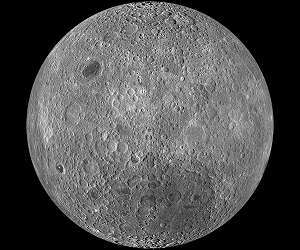
2018 could see a breakthrough in lunar exploration: China is planning a mission that, if successful, will see a space landing on the far side of the moon for the first time.
The first part of China's Chang'e 4 space mission will launch in June. A Long March 4C rocket will carry a 425kg relay satellite and station it some 60,000km behind the moon. A second launch later in the year will send a lander and rover to the far side of the moon, guided to a safe landing by the satellite.
Aboard the Chang'e 4 lander will equipment to study the geological conditions of the region, as well as a container made from aluminium alloy filled with seeds and insects.They will be used to test whether plants and animals could be grown on the moon.
"The container will send potatoes, arabidopsis seeds and silkworm eggs to the surface of the Moon. The eggs will hatch into silkworms, which can produce carbon dioxide, while the potatoes and seeds emit oxygen through photosynthesis. Together, they can establish a simple ecosystem on the Moon," Zhang Yuanxun, chief designer of the container, told the Chongqing Morning Post, according to China Daily.
Another advantage of a mission to the far side of the moon, is that a radio telescope stationed there would be undisturbed by radio signals coming from Earth, such as FM radio and the planet's ionosphere.
Astrophysicist Professor Heino Falcke of Radboud University, Nijmegen (The Netherlands) told the Guardian that he has been in talks with the Chinese and is hoping that his radio telescope will make it onto the mission. Falcke aims to use the telescope to detect low-frequency radio waves from the early universe.
"I think we built up a lot of good relations in China and there is goodwill on both sides to make this happen," the scientist said.
Quelle: SD
---
Update: 12.01.2018
.
Testing on China's Chang'e-4 lunar far side lander and rover steps up in preparation for launch
The lander and rover which China aims to soft-land on the far side of the Moon have entered mechanical environmental testing as preparations for launch in late 2018 step up.
The China Aerospace Science and Technology Corporation (CASC), the main contractor for the Chinese space programme, stated yesterday that testing had started following recently completed experiments.
The process will typically involve verifying system performance while experiencing vibrations similar to those during launch and flight as well as thermal vacuum and anechoic chamber tests.
Chang'e-4 was originally manufactured at the same time as Chang'e-3 spacecraft in order to provide a backup. Testing for Chang'e-4 will also likely involve lunar landing and lunar surface simulation for the six-wheeled rover, as with the previous mission.
CASC states that new technologies have added additional challenges to the development of China's fourth lunar mission, and includes the integration of payloads provided by international cooperation.
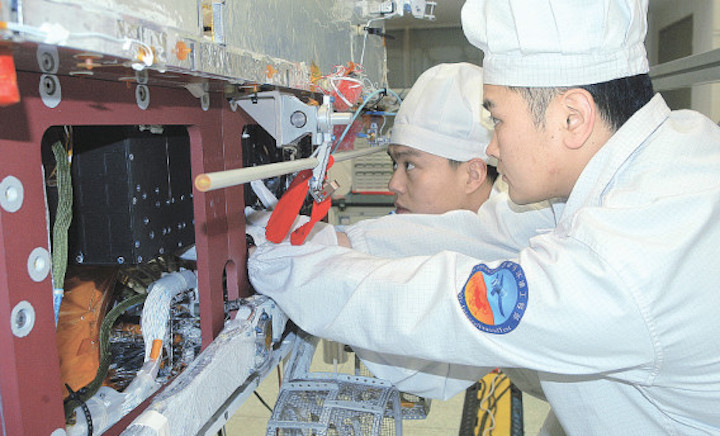
Chang'e-4 team members testing the six-wheeled rover, similar to the Yutu (Jade Rabbit) rover that set down on the Moon in late 2013. CASC
Launch plans and relay satellite
The lander and rover are expected to be launched from the Xichang Satellite Launch Centre in Sichuan in November or December this year.
Before this, in May or June, a relay satellite will be launched from same site, which will head for a Lagrange point beyond the Moon from which it can facilitate communication between the ground and the spacecraft on the lunar far side, which due to tidal locking never faces Earth.
A soft-landing on the far side of the Moon has never been attempted, though a US Decadal Survey has highlighted the significance of such as mission.
If all goes smoothly the mission will earn China international prestige but also likely significant scientific returns.
The candidate landing sites are within the South Pole–Aitken basin, a huge crater that may include lunar mantle excavated by the impact that formed it and thus offer unique insights into the interior of the Moon, what is made of, and how it formed.
The mission includes a mini ecosystem including potatoes, arabidopsis seeds and silkworm eggs, and further payloads including radio telescopes to take advantage of radio silence provided by the shielding from the Earth provided by the Moon.
Sweden, Germany, the Netherlands and Saudi Arabia are all also involved in the mission through various payloads.
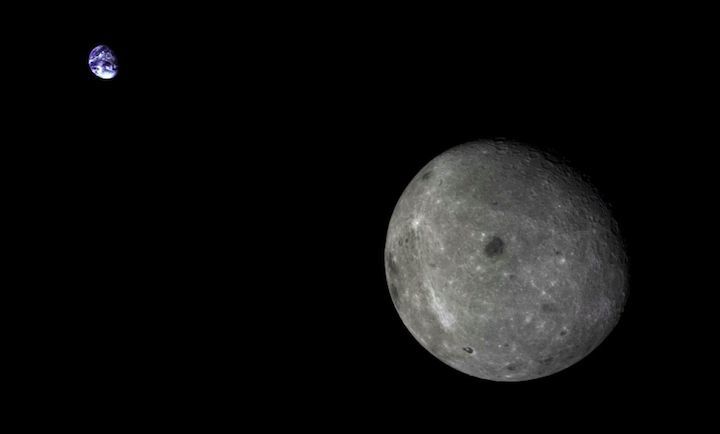
The far side of the Moon and the distant Earth, imaged by the Chang'e-5T1 mission in 2014. Chinese Academy of Sciences
Quelle: gbtimes
